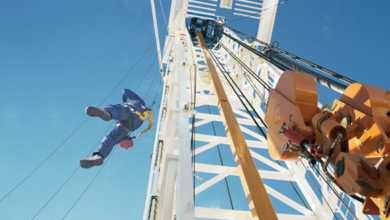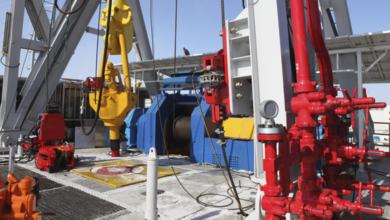D&C Tech Digest
Helix sets record for subsea wireline intervention
Helix Energy Solutions Group subsidiary Helix Well Ops announced that its Well Ops Asia Pacific team, based in Perth, Western Australia, recently set a world depth record for subsea wireline intervention. It was done from a monohull vessel by retrieving tubing hanger plugs from two subsea wells located approximately 25 m apart in 392 m of water.
The record-breaking retrieval job was accomplished on the first of the two trees after both had been landed on their wellheads. Well Ops employed its Vessel Deployment System (VDS) and Subsea Intervention Device (SID) from the monohull vessel Havila Harmony to retrieve the hanger plugs on both of the trees via wireline intervention. The VDS can work over a moonpool or create an over-the-stern moonpool work area on any vessel that allows the deployment of guidelines, podlines, lubricator and subsea equipment packages. The SID is a modular subsea lubricator that enables cost-effective rigless intervention on subsea wells.
The team also accomplished another operational feat by moving its equipment from the first well to the second without recovery to the surface. This resulted in a significant time saving benefit for the client.
SCR systems help Shell reduce NOx emissions by 90%
Based on initial testing, Shell E&P has been able to use Selective Catalytic Reduction (SCR) systems to reduce NOx emissions by 90% at Wyoming’s Pinedale Anticline. Additionally, the systems maintained an average ammonia slip of 2-3 ppm. The state of Wyoming and the Bureau of Land Management (BLM) had requested that all natural gas companies in the Pinedale Anticline reduce NOx emissions from their rigs.
Diesel engines used in natural gas drilling rigs undergo dynamic load changes throughout the drilling cycle, resulting in dramatic fluctuations in exhaust flow rate and NOx emission levels. Previous attempts by other SCR suppliers to control NOx emissions from these engines were unsuccessful, according to Johnson Matthey, which supplied the SCR systems. The company will now provide 21 additional SCR Systems to Shell.
Joint TOTAL, Sperry project targets development of MWD system for up to 450°F
Sperry Drilling Services, a brand of Halliburton’s Drilling and Evaluation Division, and TOTAL have signed a project development agreement to jointly develop an ultra-high-temperature measurement-while-drilling system (MWD) capable of operating in temperatures up to 450°F (230°C). TOTAL, on behalf of its partners on the Victoria project (Eni and StatoilHydro), and Halliburton will contribute equally to the project.
The resulting system will enable TOTAL to effectively drill and exploit reserves in its Victoria field in the North Sea.
“This project represents a commitment from both companies to push the limits for extracting hydrocarbons from high-temperature and deeply buried reservoirs,” said Brady Murphy, vice president, Sperry Drilling Services. “We already have ultra-high-pressure tools rated to 30,000 pounds per square inch. By collaborating with TOTAL, we have a strategic ally that can help us accelerate the development of an ultra-high-temperature logging-while-drilling system.”
The two companies will use innovative, industry-first technologies to accomplish the goals of this 450°F project. These include a downhole refrigeration system, cold-plate technology, flasking and phase change material – all designed to function under the high shock and vibration encountered while drilling. The work may lead to an expanded suite of logging-while-drilling sensors capable of operating at these elevated temperatures.
Record single BHA run achieved in North Sea
INTEQ, Hughes Christensen and Baker Hughes Drilling Fluids have outperformed the record for a single BHA meterage on a well in the North Sea drilled by StatoilHydro. AutoTrak, in combination with an HCC HCM607 bit and PERFFLOW Drill-In Fluid, drilled challenging multilateral hole sections to a total of 17,224 ft (5,250 m) to TD. In a single BHA run, 14,121 ft (4,304 m) were drilled.
During the 4,304-m BHA run, one open-hole geological sidetrack and two multilaterals were drilled. The BHA used for this section record consisted of AutoTrak, OnTrak, LithoTrak and CoPilot. The inclusion of CoPilot allowed INTEQ specialists to monitor and optimize drilling dynamics during the entire run from the Norway BEACON centre.
Separately, INTEQ recently drilled a six-leg extended-reach horizontal well in the Williston Basin of North Dakota. INTEQ’s 4 ¾-in. Ultra X-treme Motor technology with a 4 ¾-in. NaviGamma and Multiple Propagation Resistivity (MPR) was used to drill a total of 19,773 ft (6,027 m) in 599.2 drilling hours. A water-based mud system was used for the application with maximum temperatures reaching 275°F (135°C). This marks the first attempt of this wellbore design to be drilled in the Williston Basin, and it was deemed a significant success.
First all-electric subsea production system installed on TOTAL’s K5F project
Cameron has announced the successful start-up of first gas from the CameronDC All-Electric Subsea Production System installed as part of the K5F project developed by TOTAL E&P Nederland in the Dutch Sector of the North Sea.
The start-up marks the world’s first utilization of an all-electric subsea production system. The project includes a three-well combined template/manifold installed in 40 m of water controlled from an existing platform 18 km away. Production is piped back to an unmanned platform 10 km away. The initial installation encompasses two template/manifold-mounted trees with the option for two additional trees in the future, one of which would be a satellite tree. The system includes:
• Fully redundant, all-electric control system configured for four wells, including tree-mounted Electric Subsea Control Modules (ESCMs), manifold-mounted Power Regulation and Control Modules (PRCMs), including end terminations for the coaxial cable supplying power and communication, Master Control Station (MCS), Electric Power and Communications Units (EPCU) and sea water return cathode/anode system.
• CameronDC Christmas trees with electrically actuated production and annulus valves, electrically actuated chemical injection valves, and electrically actuated insert-retrievable chokes.
The system features full redundancy throughout and offers feedback during operation, including instantaneous feedback on valve and choke operation and the ability to track operational characteristics throughout the life of the system. Valve-mounted spring packages ensure that the system is fail safe close should a loss of power or communication occur. In addition, the system is completely all-electric from surface to subsea.
“This is a milestone achievement for both Cameron and Total,” said Hal Goldie, president of Cameron’s Drilling & Production Systems Subsea Division.
PV Drilling jackup drills longest well in Cuu Long Basin offshore Vietnam
PV Drilling’s first jackup rig, PV Drilling-I, has accomplished several milestones in the drilling of well 9-2-CNV-2P, which was drilled to a total measured depth of 6,526 m. This depth represents the longest well drilled in the granite basement in the Cuu Long Basin in Vietnam to date.
An earlier success was recorded in the drilling of the 12.114-in. hole section of the same well to the top of the granite basement. This was recorded as a significant operational accomplishment and proved that difficulties that have previously been encountered in drilling the deeper clastics sections at Ca Ngu Vang can be surmounted in future operations. “This again is clearly a direct result of the professional attitude and positive team work exhibited by the personnel who operate PV Drilling-I,” said Ngo Huu Hai, general manager at Hoan Vu JOC, in a letter to PV Drilling CEO Do Van Khanh.
The latest achievement was made following the re-entry of the well, drilling to the original target total depth and then deepening the 8.112-in. hole section.
To reach the total depth of 6,526 m, a total of 2,238 m of granite was drilled. The final vertical depth of 4,608 m represents the deepest hole section drilled into the basement. Additionally, the drilling of the section from the previously drilled depth was completed five days ahead of schedule.
It is also recognized that these operational accomplishments have been made with an excellent HSE record and virtually zero mechanical down time or recordable NPT, according to Hoan Vu JOC.



